How to install ducts: installing flexible and rigid ventilation ducts
Modern offices, residential buildings, industrial buildings need to ensure normal air exchange and proper ventilation. For the construction of an organized system, ducts are installed. They are installed both inside the buildings ‚and outside. But a complete ventilation system is needed at home, do you agree with this?
Knowing the principles of the arrangement of the system and the nuances of connecting the ducts in a certain sequence, it will be possible to create a functional ventilation network. But how to do it right? Let's figure it out together - this article discusses the types of air ducts used to create ventilation systems.
And also details of the installation of flexible and rigid channels are analyzed in detail. For clarity, the article is supplemented by thematic photos, diagrams, detailed video instructions for installing and securing air ducts.
The content of the article:
Duct classification principle
Ducts are called a pipe system, adapted for the movement of air through it and arranged in a certain way.
They are used for installation of ventilation systems in houses ‚duct networks form ventilation systems and air conditioning ‚with their help connect industrial andcooker hoods‚Used in air heating systems.
Based on the design, they are divided into round and rectangular. The round air ducts are ergonomic, the air moves along them almost silently, the vibration during operation is insignificant.
Connect the elements of the duct with a circular cross section without the use of additional elements.
A rectangular section of the duct is preferable when the system needs to be made invisible by hiding it under the finish.
This and a satisfactory level of throughput is due to their choice when installing a ventilation system in residential buildings. In addition, ducts are rigid and flexible.
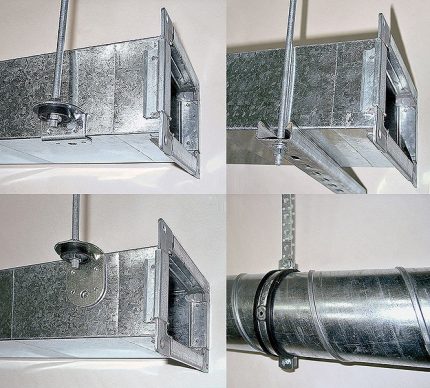
For the former, the cross section can be either round, or rectangular, and the latter, in the section, have only a circle. Their use is appropriate at branch points. Produce flexible air ducts (corrugation) mainly from aluminum foil ‚polyester‚ although there are also products made of silicone ‚textile‚ rubber resistant to aggressive chemicals.
They are connected directly to the fans ‚supply and exhaust anemostats‚ grilles directly, but sometimes, in order to connect such an air duct to the main system, connecting and mounting parts are additionally needed.
Inside, the surface of the flexible ducts is not particularly smooth, so the increased aerodynamic drag creates additional noise.
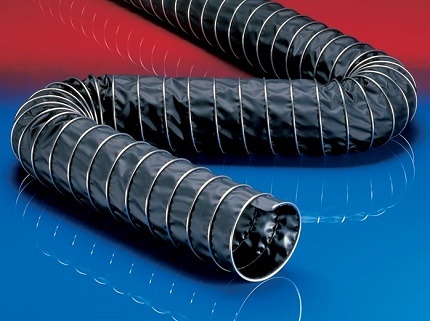
The structure of flexible ducts is multi-layered. For greater rigidity, a steel wire is placed between the layers. Most often ventilation ducts in residential buildings are laid from PVC pipes with high sound-absorbing and heat-insulating characteristics.
Corrugation is used in those places where the speed of the air mass does not exceed 30 m / s, and the pressure is not higher than 5 tons. Pa.
Air ducts in their design can be built ‚in the form of ventilation shafts‚ and external ‚laid on walls and ceilings. The first is located inside the walls.
For them to work efficiently their surface inside should be as smooth as possible ‚then air will circulate freely‚ without bumping into any interference. At the bottom of the shaft there is a hole that allows you to clean the duct.
Suspended and attached ducts are used for external air ducts. They are an assembly consisting of pipes and connectors of various sizes and shapes. Based on such a sign ‚as the presence of insulation‚ air ducts are insulated and without insulation.
Based on the design of the premises and the structural features of the building, they opt for a specific air ducts.
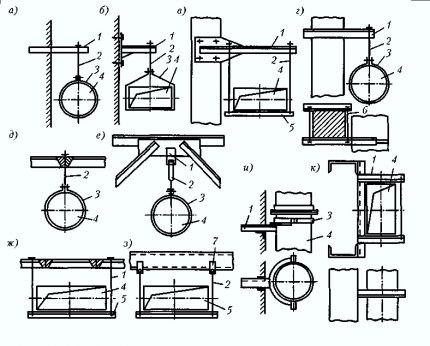
The installation of the system must be preceded by a high-quality aerodynamic calculation. It will be necessary to determine the pressure in the system, the volume of air masses passing through the duct, its cross section, and the type of air exchange.
Aerodynamic calculation of the duct
To determine the size of the duct in the context, you need a sketchy version of the air network. First, the cross-sectional area is calculated.
For a round pipe, the diameter is found from the formula:
D = √4S / π
If a rectangular section is found, its area is found by multiplying the length of the side by the width: S = A x B.
After calculating the cross section and applying the formula S = L / 3600V, the volume of air replacement L in mᶾ / h is found.
The speed of air movement in the duct in the area of the supply grille is recommended to be taken in the range from 2 to 2.5 m / s for offices and housing and from 2.5 to 6 m / s in production.
In the main air ducts - from 3.5 to 6 in the first case, from 3.5 to 5 - in the second and from 6 to 11 m / s - in the third. If the speed exceeds these indicators, the noise level will increase above the standard value. Coefficient 3600 coordinates seconds and hours.
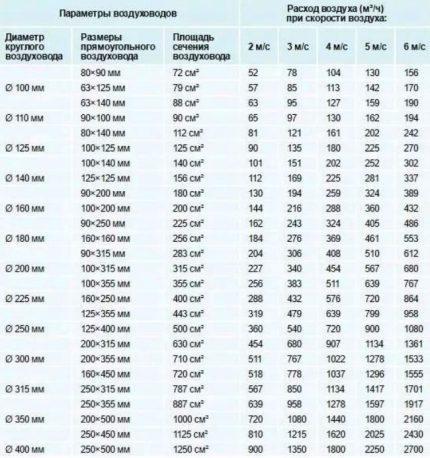
From the table, focusing on the speed of the air flow, you can take the estimated consumption of air mass.
You may also be interested in the detailed information on calculating the area of air ducts with calculation examples, discussed in our other article.
Features of duct installation
Regardless of the type and functions assigned to the ventilation system, the main task of transporting air is to carry out channels for conveying the air flow in it. Of all the installation work on the system, the most difficult part is the installation of air ducts.
Even with a correctly executed calculation, having violated the technology, it will never come out to create a system that works without failures.
In addition to the main tasks, ventilation can perform a number of additional functions:
- monitor the cleanliness of the air supplied to the room;
- maintain a given percentage of moisture;
- to free air from any impurities that is removed from the building.
On device exhaust ventilation you need only one duct. AT supply and exhaust system laying of two independent air ducts is required so that one of them receives clean air and the other leaves used air.
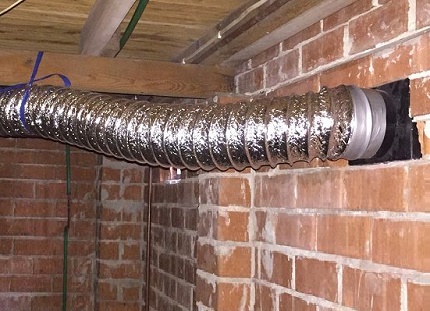
General installation rules
There are documents that spell out the requirements for installation and operation of ducts. These include SP 60.13330 and SP 73.13330.2012. The first is called “Heating‚ ventilation and conditioning ”and the second is“ Internal sanitary systems of buildings ”.
In addition ‚manufacturers‚ producing air ducts ‚enclose their instructions to them.
The requirements subject to strict compliance include:
- Full stretching of flexible ducts during installation.
- No sagging to avoid pressure loss.
- Mandatory groundingthe trunk has the ability to accumulate static electricity.
- Do not plan to install flexible and semi-rigid ducts if the vertical section of the system is a route spanning more than 2 floors.
- Install extremely rigid pipes in the basement ‚basements‚ in concrete structures ‚in places of contact with the ground.
- At the design stage and during the installation of flexible and other ducts, one should take into account the moment that in the working ventilation system the air path is a spiral.
- When cornering, lay a radius equal to at least two pipe diameters.
- Conduit through the walls using special metal sleeves and adapters.
- Duct damaged during installation ‚must be replaced.
Most often, air ducts are attached to the walls ‚ceiling‚ in the space between the ceiling trusses. It remains unchanged that the center of the ducts and the plane of the structures must remain parallel with respect to each other.
The regulations also regulate the minimum distance from the air duct to other structures.

When laying ducts, 2 options are possible. First, the combined pipes make up a system with a common outlet pipe. The second - each room has an individual duct.
Types of connections for rigid ducts
When installing the ventilation system, it is recommended to make as few connections as possible. Combine air ducts with flange and retaining brackets.
In the first case, the fittings and pipe ends are supplemented with flanges, then connected using self-tapping screws ‚with rivets, placing them every 200 mm‚ or by welding. The use of rubber gaskets is used as a seal for flanges.
The manufacture of flanges is a complex process and not very profitable for the manufacturer.
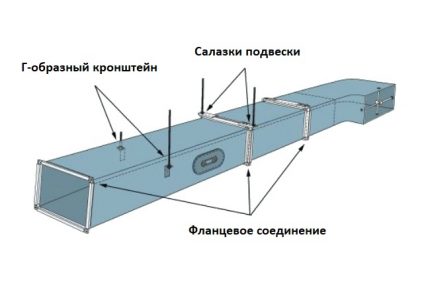
A bandage or flangeless connection is more profitable both financially and in terms of time. It provides for the imposition on the joint of the bandage, which is a thin metal strip or rail. This type of connection is also not perfect.
The main thing is that the tightness is low, due to which the joints become places of air leakage, and at minus temperatures condensate accumulates here.
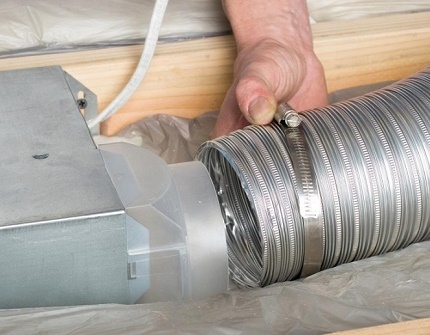
There is a third way to connect when installing rigid ducts - a bus and a corner. This is an invention of Metz engineers from Germany. Now it is successfully gaining ground from the first two methods. For cutting tires you do not need expensive equipment, and the corner is made by stamping.
Duct Mounting Methods
There are 4 ways to fix the ducts:
- hairpin plus profile;
- hairpin and traverse;
- hairpin plus clamp;
- punched tape.
The first of these methods is used by professionals. The used profile has L or Z-shaped form. The second is mainly fixed by heavy ducts. Reduces the load on the fasteners and provides additional rigid support for the duct corner ‚installed under the lower corner.
In the place of attachment of the profile, rubber seals are placed. They are needed to reduce noise and dampen vibration.
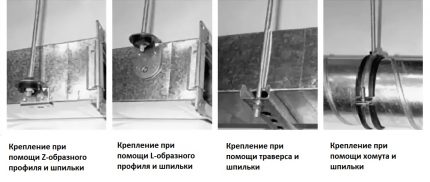
When installing heat and sound insulated ducts, where the line width is more than 60 cm, the second method of fastening is used. The load from the duct itself falls on the beam, and studs are insured against horizontal movements.
For better isolation from noise, a rubber profile is also required. Place it between the body of the duct and the traverse.
To install round ducts - simple or insulated, the third method is used - a hairpin and a clamp. In small sections of the duct ‚made of flexible pipes‚ you can do with only clamps. A simple and cheap way is fixing with a punched tape.
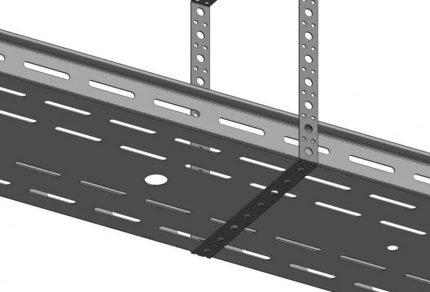
For a round duct, a loop is made of punched tape, and for a rectangular duct, they are connected to bolts. This method is used for systems with a diameter of not more than 20 cm; the design does not have sufficient rigidity.
On the back side, the duct is fixed directly to the ceiling structures by means of an anchor connection or using a clamp.
Flexible pipe installation
Flexible ducts are easier to install than rigid ones.
The technology consists of the following operations:
- Cutting. Air duct ‚to improve aerodynamic performance‚ stretch ‚measure and mark the length. Next ‚make a cut along the turn.
- Connections. The air duct is put on the nozzle with a minimum of 5 cm entry. In this case, it is necessary to take into account the direction of air movement marked with a colored mark on the flexible pipe. Proper installation reduces the noise level in the system.
- Sealing. Seal the joint using sealant or special aluminum tape. Fix the duct using a hose clamp.
In the case of mounting insulated sleeves, the same technology is used, but when the duct is cut off or sections thereof are connected, the insulation layer is pre-wrapped.
The bare frame is joined or cut off, the connection is sealed and only then the insulation is returned to its place. After that, it must be fixed again and insulated.
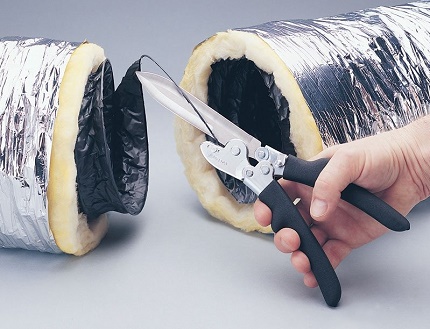
Attachment points should be at a distance of 1.5 - 3 m from each other. Sagging between them is allowed no more than 5 cm per 1 m. If the duct is parallel and higher than the ceiling structures, the distance between the axes of the clamps is 100 cm.
When the duct occupies a vertical position ‚the distance between the fasteners is increased to a maximum of 180 cm. Coverage of the duct with a clamp cannot be less than ½ of the diameter of the first.
If you need to make turns, you need the largest possible radius. With a decrease in this parameter, the pressure drops. It is optimal when the bend radius is 2 pipe diameters.
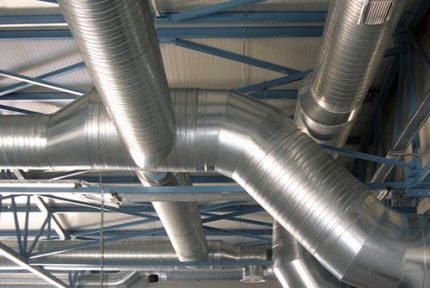
A flexible duct that is not exposed to weathering and ultraviolet radiation will not last long if installed outdoors.
Flexible duct ‚made of metal polyester tape‚ in contact with the heating pipe will surely sag and quickly age. Do not allow the contact of air ducts made of different metals - this also negatively affects their useful life.
Significant damage to the synthetic ducts static electricity. With its large accumulation and the occurrence of a discharge, an explosion can even occur.Such a situation is possible ‚when in the air‚ moving with considerable speed‚Pairs of natural solvents are present.
Grounding will help in this case. To do this, the ground wire is connected to the wire forming the duct frame. If this is an exhaust system located above the equipment, a spiral wire is led to its body.
Conclusions and useful video on the topic
Here you will see how specialists install ductwork:
Plastic ducts and their installation:
It is important to initially have a competent project for laying ducts. Having familiarized yourself with the types and features of installing various types of air ducts, you can deal with the installation of a simple system yourself.
Bulky and complex designs are best left to professionals.
Do you have not only theoretical knowledge, but also practical experience in installing ventilation ducts? Perhaps you noticed a discrepancy in information or technical errors in the material reviewed? Please write to us about this in the comments under the article.
If you have any questions or want to clarify some point on installing the air ducts, ask for advice - we will try to help you.

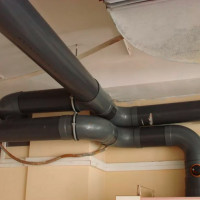 Installation of plastic ventilation ducts: a guide to the construction of a system of polymer pipes
Installation of plastic ventilation ducts: a guide to the construction of a system of polymer pipes 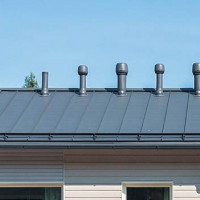 Installation of ventilation on the roof: installation of the ventilation outlet and air supply units
Installation of ventilation on the roof: installation of the ventilation outlet and air supply units 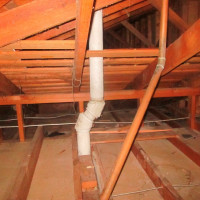 Arrangement of ventilation from sewer pipes: the construction of ducts from polymer products
Arrangement of ventilation from sewer pipes: the construction of ducts from polymer products 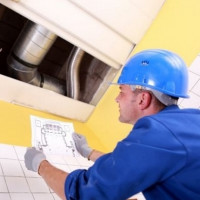 Ventilation restoration: causes of reduced efficiency and duct restoration
Ventilation restoration: causes of reduced efficiency and duct restoration 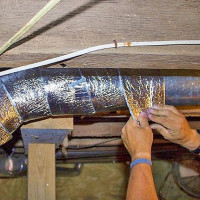 How and how to insulate the ventilation pipe: rules and regulations for insulation of ducts
How and how to insulate the ventilation pipe: rules and regulations for insulation of ducts 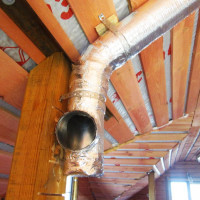 How to insulate ventilation in a cold attic: the specifics of thermal insulation of air ducts
How to insulate ventilation in a cold attic: the specifics of thermal insulation of air ducts  How much does it cost to connect gas to a private house: the price of organizing gas supply
How much does it cost to connect gas to a private house: the price of organizing gas supply  The best washing machines with dryer: model rating and customer tips
The best washing machines with dryer: model rating and customer tips  What is the color temperature of light and the nuances of choosing the temperature of the lamps to suit your needs
What is the color temperature of light and the nuances of choosing the temperature of the lamps to suit your needs  Replacement of a geyser in an apartment: replacement paperwork + basic norms and requirements
Replacement of a geyser in an apartment: replacement paperwork + basic norms and requirements
Wherever possible, non-return flaps should be installed. This will prevent dust and extraneous odors from entering the room when ventilation is not working. Try to mount the fans in easily accessible places, so that if necessary, replace the device without additional work. Install filter elements in places of air intake, for example, from caprolon. Change them at least once every six months.
“Wherever possible it is necessary to install non-return flaps.” “Non-return flaps”? 🙂 The professional wrote right away, divorced them in the ventilation today ... 🙂
Let's just say, “L or Z-shaped profile” is thought up on Systemair. We do not have this in technological maps. Yes, and put them longer and more laborious. On traverse or tape faster.
Our installers put them on the “fleas” and eat it all. And according to our rules, these profiles must be fastened to the duct on RIVETS or welded (which is unrealistic with thin-sheet and galvanized steel).
Installing fasteners on the duct flanges is also UNACCEPTABLE (this is a photo with a slide on the flanges for suspensions)!